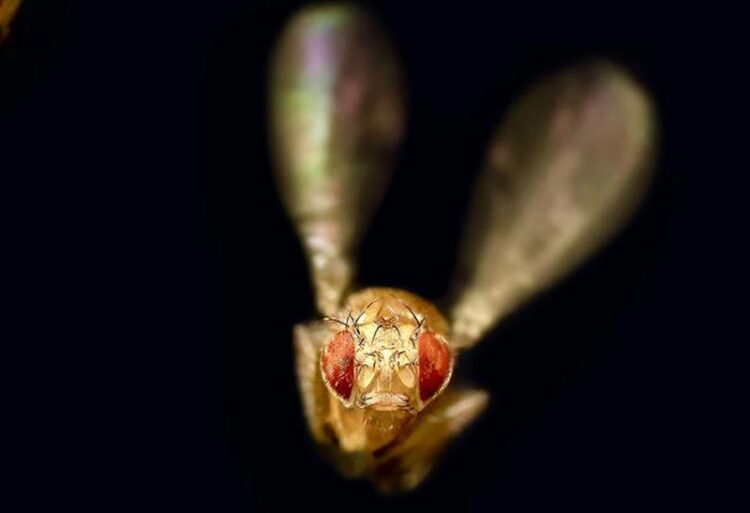Novel mechanism for flight control in fruit flies

Fruit fly in flight
(c) Silvan Hürkey
Researchers at the Institute for Theoretical Biology at Humboldt Universität have solved a long-standing mathematical puzzle about the emergence of electrical activity patterns during insect flight. Together with colleagues at the Johannes Gutenberg University in Mainz, they report a novel function for electrical synapses in governing the flight of fruit flies in the current issue of Nature.
To keep their small bodies up in the air, fruit flies have to beat their wings extremely fast. They use a trick that is widespread in the animal kingdom: their nerve cells do not keep pace with the flapping of their wings. In order to control the flight muscles, each nerve cell rather generates an electrical pulse – also called action potential – only about every twentieth wing beat. This action potential, however, is precisely tuned to interact with other nerve cells. In a small circuit consisting of a few nerve cells, special activity patterns are generated: each cell regularly fires pulses, yet not at the same time as the other cells but rather spread out asynchronously at fixed intervals relative to each other.
In the fruit fly, such activity patterns have been known since the 1970s. Until now, their emergence was attributed to a connectivity of the nerve cells via chemical synapses. It was assumed that inhibitory messenger substances between nerve cells are released in response to action potentials, mutually preventing the cells from generating pulses at the same time. Using mathematical analysis, however, Prof. Susanne Schreiber’s team has now been able to show that such pulse-distributed activity can also occur when the nerve cells are not connected chemically, but electrically – that is, without the use of messenger substances. In this case, the cells have to use a special kind of action potential that comes along with a high sensitivity to the inputs from others, especially when a cell has just been active. This type of sensitivity is not typical of ‘normal’ action potentials and, therefore, in the latter case no pulse-distributed activity is to be expected if the cellular coupling is purely electrical.
Experimental evidence for the type of pulse generation predicted by the Berlin researchers was provided by Prof. Carsten Duch’s research group in Mainz. The scientists strengthened or weakened certain ionic currents in the cells of the fruit fly in order to change the type of action potentials that were generated. They were able to show that these manipulations influenced the activity patterns in the flight circuit exactly as predicted by the mathematical model. In addition, they proved that the connections among cells are indeed electrical and that knocking down this coupling has the expected effects on the activity patterns and wing beats of the animals.
The finding of the teams in Berlin and Mainz is particularly surprising, as it had so far been assumed that electrical coupling serves to promote the simultaneous activity of nerve cells. The activity patterns arising from electrical synapses reveal new principles of information processing in nervous systems. The same mechanism could be used not only in thousands of other insect species but also in the human brain, where the function of electrical coupling is still far from being understood.
Wissenschaftliche Ansprechpartner:
Dr. Jan-Hendrik Schleimer
Tel.: 030 2093-98407
E-Mail: jh.schleimer@hu-berlin.de
Nelson Niemeyer
E-Mail: nelson.niemeyer@hu-berlin.de
Prof. Dr. Susanne Schreiber
E-Mail: s.schreiber@hu-berlin.de
Fachinstitut für Theoretische Biologie (ITB) und Bernstein Center for Computational Neuroscience Berlin, Humboldt-Universität zu Berlin, Philippstr. 13, 10115 Berlin
Originalpublikation:
Hürkey S*, Niemeyer N*, Schleimer J-H, Ryglewski S, Schreiber S#, Duch C# (2023): Gap junctions desynchronize a neural circuit to stabilize insect flight. Nature. https://doi.org/10.1038/s41586-023-06099-0
*Equal contribution. #Shared corresponding authors.
https://www.nature.com/articles/s41586-023-06099-0.epdf?sharing_token=cTD1y96A3u…
Media Contact
All latest news from the category: Life Sciences and Chemistry
Articles and reports from the Life Sciences and chemistry area deal with applied and basic research into modern biology, chemistry and human medicine.
Valuable information can be found on a range of life sciences fields including bacteriology, biochemistry, bionics, bioinformatics, biophysics, biotechnology, genetics, geobotany, human biology, marine biology, microbiology, molecular biology, cellular biology, zoology, bioinorganic chemistry, microchemistry and environmental chemistry.
Newest articles

NASA: Mystery of life’s handedness deepens
The mystery of why life uses molecules with specific orientations has deepened with a NASA-funded discovery that RNA — a key molecule thought to have potentially held the instructions for…

What are the effects of historic lithium mining on water quality?
Study reveals low levels of common contaminants but high levels of other elements in waters associated with an abandoned lithium mine. Lithium ore and mining waste from a historic lithium…

Quantum-inspired design boosts efficiency of heat-to-electricity conversion
Rice engineers take unconventional route to improving thermophotovoltaic systems. Researchers at Rice University have found a new way to improve a key element of thermophotovoltaic (TPV) systems, which convert heat…



